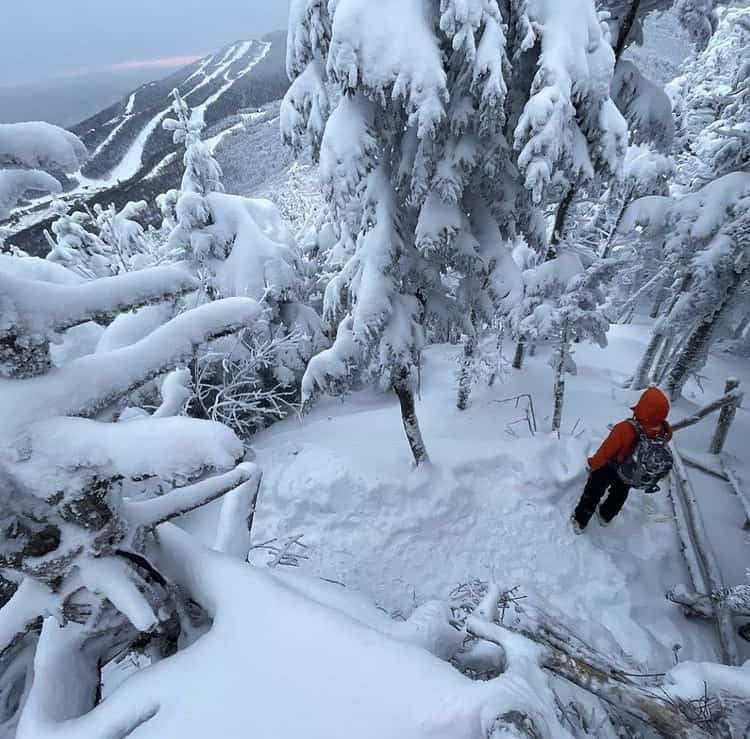
Merisa Sherman surveys the view of Killington, illuminated by the soft light of sunrise.
By Merisa Sherman
It’s cold. And not just a little bit cold but the kind of cold where you can put your hand on the wall of your house and feel the outside seeping in. It’s the kind of cold where you learn all the little cracks and crevices that will need to be re-caulked and insulated once summer rolls around. A cold where you can hear the crackling of the fire at the same time you hear the moaning of the house. The kind of cold where you grab a good book and snuggle under three blankets just to stay warm.
Or you can get up before the dawn and meet your friend to ski up a mountain in the dark. It’s brutally cold as you begin, a little underdressed because you know your heart rate will climb as you do. You can hear the cold snow squeaking underneath your skis as you slide along, moving as quickly into the woods as you can – a little dash to get out of the bitter wind and wake up your body from the cozy warmth of the car.
Once you’re in the woods, it’s almost like entering a log home. So many trees together divert the wind and you’re free to take down your hood and enjoy watching the sun turn all shades of pink around you. Some days, you can see the steam rising out of the neck of your jacket as you break trail through the freshly fallen snow. On others, you can feel the cold air burning your nostrils and your lungs as you inhale. Your eyelashes start to freeze together as you sweat, sometimes so quickly that it’s difficult to open your eyes after blinking. That’s when you know it’s really cold.
During World War II, my grandfather served as the first gunner’s mate aboard a merchant marine vessel transporting TNT to Russia through the Arctic Sea as part of the Lend-Lease Appropriations program. Yeah, that’s right. He sailed on a ship full of explosives past the aggressive Nazi U-boats stationed on the Norwegian shore – a mission with a survival rate well below 50%.
A born-and-raised southern Georgia boy, he was a little overwhelmed by the sheer brutality of the Arctic cold. He recorded in his journal that it was so cold that eyelashes would fall off during watch and that Jello could be made in 15 seconds just by putting the bowl outside. His captain was constantly worried that their big gun, Penelope, would freeze up in the arctic weather and leave them vulnerable to attack. While my grandfather never recorded the actual temperature, historians show that 1939-1942 were some of the coldest, most brutal winters on record.
Just like the Arctic, the cold is just a part of life in Vermont. Nordic ski races are cancelled or postponed only when the mercury dips below -4 F, and only because you’re breathing so heavily with so little clothes on, that the cold air starts to freeze your lungs. For the casual skinner or skier, we’re not reaching anywhere that amount of lung usage and we are certainly wearing more clothes than a competition skin suit. In its whole existence, I believe Killington has only ever closed for ONE DAY because of the cold – it was -50 F at the peak without the windchill. If my grandpa and his fellow sailors could survive the Arctic during those brutally cold winters of the war, we can certainly skin up a mountain or ride the chairlift for a few runs when it’s a wee bit chilly.
And so we do. We meander through the woods on a grand adventure, knowing that our big puffy coats, warm hats and thick mittens await patiently in our packs. As always, there’s an emergency bivvy in my pack, as well as one of those paper emergency blankets to make a shelter. I’ve got a pair of hand warmers in my first aid kit and on a really cold day, an open pair already warming up my mittens for the descent. There’s warm water in myThermos and snacks galore in my pack. We might be crazy enough to seek out these adventures, but we also travel prepared with the right gear — and the knowledge to use it.
Our cheeks are rosy and our eyelashes covered in white, but our smiles are frozen in place as we take in the view from the summit of our ski tour. We get to see things that otherwise might not be seen and experience adventures that might not be had. Our willingness to take on the cold and the dark only strengthens our connection to these mountains. Yes, the journey might be tough and even slightly dangerous, but the reward is oh so wonderful. For these Green Mountains aren’t just beautiful on a perfect day, but all the other days in between.



